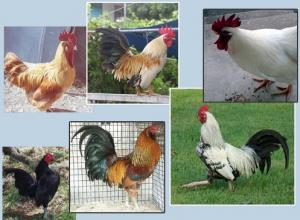Division Fern-like. Fern (lat. Polypodióphyta) is a division of vascular plants, consisting of many families. Description of the appearance of a fern leaf
Fern is one of the oldest higher plants, appearing about 400 million years ago in the Devonian period of the Paleozoic era.
Here is information about plants called Fern from Wikipedia:
Giant plants from the group of tree ferns largely determined the appearance of the planet at the end of the Paleozoic - beginning of the Mesozoic era.
Modern ferns are among the few ancient plants that have retained significant diversity comparable to that of the past.
Ferns vary greatly in size, life forms, life cycles, structural features and other features.
Their appearance is so characteristic that people usually call them all the same - “ferns”, not suspecting that this is the largest group of spore-bearing plants: there are about 300 genera and more than 10,000 species of ferns.
The variety of leaf shapes, amazing ecological plasticity, resistance to waterlogging, and the enormous number of spores produced have determined the wide distribution of ferns around the globe.
Ferns are found in forests - in the lower and upper tiers, on the branches and trunks of large trees - as epiphytes, in rock crevices, in swamps, in rivers and lakes, on the walls of city houses, on agricultural lands as weeds, on roadsides.
Ferns are ubiquitous, although they do not always attract attention. But their greatest variety is where it is warm and damp: the tropics and subtropics.
Ferns do not yet have true leaves. But they took the first steps in their direction. What a fern resembles a leaf is not a leaf at all, but by its nature is a whole system of branches, and even located in the same plane.
So this is called a flat branch, or a frond, or, another name, a pre-shoot. Despite the absence of a leaf, ferns have a leaf blade.
This paradox is explained simply: their flat branches and pre-shoots underwent flattening, as a result of which a lamina of the future leaf appeared - almost indistinguishable from the same lamina of a real leaf.
But evolutionarily, ferns have not yet had time to divide their fronds into stems and leaves. Looking at a frond, it is difficult to understand where the “stem” ends, at what level of branching, and where the “leaf” begins. But the leaf blade is already there.
Only those contours within which the leaf blades united so that they could be called a leaf did not appear. The first plants to take this step are gymnosperms.
Ferns reproduce by spores and vegetatively(growths, rhizomes, buds, aphlebia, etc.). In addition, ferns are characterized by sexual reproduction as part of their life cycle.
Ferns include both herbaceous and woody life forms.
fern leaf
The body of the fern consists of leaf blades, a petiole, a modified shoot and roots (vegetative and adventitious). Fern leaves are called fronds.
In temperate forests, ferns usually have a short stem, which is a rhizome found in the soil. The stem has well-developed conducting tissue, between the bundles of which the cells of the main parenchymal tissue are located.
Fronds (fern leaves) unfold above the soil surface, growing from the buds of the rhizome.
These leaf-like organs have apical growth and can reach large sizes, usually serving two functions - photosynthesis and sporulation.
Sporangia are located on the lower surface of the leaf, and haploid spores develop in them.
Life cycle
In the life cycle of a fern, asexual and sexual generations alternate - sporophyte and gametophyte. The sporophyte phase predominates.
The sporangium opens at the bottom of the leaf, the spores settle on the ground, the spore germinates, a shoot with gametes appears, fertilization occurs, and a young plant appears.
In the most primitive ferns (creeper ferns), sporangia have a multilayer wall and do not have special devices for opening.
In more advanced ones, the sporangium has a single-layer wall and adaptations for active opening. This device looks like a ring. Already among primitive ferns, heterosporousness can be traced.
Modern ones have a small number of homosporous species. The gametophyte of homosporous plants is usually bisexual. In primitive people it is underground and always in symbiosis with mushrooms.
In advanced gametophytes, the gametophytes are aboveground, green and quickly maturing. They usually look like a green, heart-shaped plate.
Gametophytes of heterosporous ferns differ from homosporous ferns (in addition to their dioeciousness) by a strong reduction, especially of the male gametophyte.
The female gametophyte, which consumes reserve nutrients from megaspores, is more developed and has nutritional tissue for the future sporophyte embryo. Moreover, the development of such gametophytes occurs inside the membranes of mega- and microspores.
According to some sources, ferns originated from mosses. However, some scientists believe that horsetails, mosses, mosses and this section originated from psilophytes.
In the Devonian period, seed ferns evolved from spore ferns. They belonged to the first gymnosperms. From them descended all other gymnosperms and, probably, flowering plants.
Economic importance
The economic importance of ferns is not so great compared to seed plants.
Species used for food include common bracken (Pteridium aquilinum), common ostrich (Matteuccia struthiopteris), cinnamon osmunda (Osmunda cinnamomea) and others.
Some species are poisonous. The most toxic of the ferns growing in Russia are representatives of the genus Dryopteris, the rhizomes of which contain phloroglucinol derivatives.
Extracts from shieldweed have an anthelmintic effect and are used in medicine. Some representatives of the genera Kochedyzhnik (Athyrium) and Ostrich (Matteuccia) are also poisonous.
Some ferns (nephrolepis, kostenets, pteris and others) have been used as indoor plants since the 19th century.
The fronds of some shield plants (for example, Dryopteris intermedia) are widely used as a green component of floral compositions. Orchids are often grown in a special “peat” made from densely intertwined thin roots of the plant.
The trunks of tree ferns serve as building material in the tropics, and in Hawaii their starchy pith is used as food.
Fern in geology
Presumably, ferns could take a large part in the formation of fossil coals - when they are buried by sediment and there is no access to oxygen. Imprints of ancient ferns are not uncommon in coal seams.
Thus, ferns are included in the global organic cycle and, in particular, in the carbon cycle of planet Earth.
Rocks composed of ferns are called bioliths (“stones of biological origin”), they are also fossil fuels.
Here is more information about plants called ferns:
If you have a large shady corner with moist soil in your garden, there is a direct reason to plant a garden of ferns in it.
The diversity of these ancient plants allows them to be used as a component of almost any element of landscape design - from rockeries to interesting solo compositions.
Fern gardens look very environmentally friendly, like a piece of ancient nature not destroyed by civilization.
Knowing the peculiarities of the biology of these plants and taking advantage of the diversity of ferns, throughout the summer you can admire either the unusual reddish young shoots, or the openwork patterns of the fronds, or the change in their color, getting unusual, fantastically beautiful pictures.
Due to the widest species diversity, ferns can be used in gardens of various styles - both regular and landscape - including both solitary plantings and landscape compositions.
Regular style gardens are characterized by planting ferns in shady areas such as a pond, fountain or grotto. This style is characterized by straightness and graphic rigor of lines.
Choosing species with a clearly defined leaf texture, such as combed shield with lance-shaped fronds, varieties of female kochedednik - “ Crictatum", the shape of which resembles an open fan, and " Frizelliae", with fronds jagged along the edge, you can ensure that the entire composition in a regular style will sparkle with new facets.
In landscape gardens, interesting compositions are formed from them, selecting varieties and forms that harmonize or contrast with each other in the shape of the fronds and their color.
The latter trend in gardening is especially fashionable; besides, anyone can create a small garden of ferns, the main thing is that the site has a shady corner and loose, fertile soil with constant moisture.
And for those owners whose plot is located in a natural forest, creating a garden of ferns is generally the best solution to the problem of how to transform the plot without disturbing its naturalness.
Fern thickets in a landscape garden.
We will definitely grow Ferns in the eco-park, and under suitable conditions in fairly large quantities.
I strongly recommend visiting the page and be sure to familiarize yourself with 25 more Aquatic plants: the inhabitants of a reservoir need many Aquatic plants, because some of them supply the inhabitants of the reservoir with oxygen, and some with food. In addition, thickets of aquatic plants contribute to the reproduction of many fish and allow fry to hide from predators, which increases the natural productivity of reservoirs.
I invite everyone to speak out in
Ferns are ancient representatives of the flora that have dominated the surface of the globe since prehistoric geological eras. They appeared about four hundred million years ago.
Prehistoric and modern representatives
At a certain period, ferns were the dominant species of ancient flora. These plant species had enormous sizes and incredible biological diversity. Ferns in ancient times had not only herbaceous, but also woody forms.
Modern ferns are modified forms of giants from the group of spore plants that once existed on Earth. However, despite the loss of their former greatness, in certain areas they remain out of competition. Russian forests, which occupy the temperate zone, are covered in places with dense thickets formed by ostrich, bracken and other species.
Habitats
Representatives of the detachment settled all over the world. Everywhere you look in the forests of any continent, you will see ferns. Its species are ubiquitous, they have spread widely across the Earth. The widespread growth of ferns is facilitated by leaves of varied shapes, excellent ecological plasticity, and tolerance to wet soils.
The maximum diversity was observed in those ferns that chose humid tropical and subtropical regions, inhabiting damp rock crevices and mountain forested areas. In the temperate zone, shady forests, mountain gorges, and swampy areas became their abode.
Whatever the appearance of the fern, you will definitely notice the plant in both the lower and upper tiers of the forest. Some species, classified as xerophytes, scattered over the rocks and nestled comfortably on the mountain slopes. Ferns from the hygrophyte category settled in the water of swamps, rivers and lakes. Representatives from the group of epiphytes chose to live on the branches and trunks of large trees.
Description
Ferns are vascular plants. This category is a union of ancient higher and modern ferns located in an intermediate niche, on one side of which there are rhinophytes, and on the other, a group of gymnosperms.
Ferns, unlike rhinophytes, have a root system and leaves, but no seeds, unlike gymnosperms. In the Devonian era, the age of fish and amphibians, ferns, evolving, gave birth to the division of gymnosperms, which, in turn, degenerated into the order of angiosperms.
The only class Polypodiopsida, formed by eight subclasses, three of which died during the Devonian, was included in the fern division. Currently, the category is represented by 300 genera, uniting about 10,000 varieties. These spore plants formed the most extensive order.

Each fern has a number of distinctive features. The species are dissimilar in size and appearance, and their life forms and cycles are very different. However, plants have characteristic features that distinguish them from representatives of other departments.
Among them there are individuals of herbaceous and woody forms. Plants are formed by leaf blades, petioles, modified shoots, and a root system with vegetative and adventitious roots. The appearance of the fern is the same. A beautiful rosette develops above the underground rhizome, formed by curved pinnate whole-leaf or lanceolate leaves, or rather fronds.
The sizes of plants vary over a huge range: from tiny ones (no more than a few centimeters), crowded into rock crevices or wall masonry, to giant tree-like representatives - inhabitants of the tropics.
Vaii
Ferns lack true leaves. Evolutionary transformations endowed them with prototypes of leaves, looking like a system of branches laid in one plane. Botanists call this phenomenon a flat branch, frond or pre-shoot. The appearance of the fern leaf is made up of complex dissected fronds, which are smooth or pubescent, thin or leathery, light or dark green.

The preshoots, which develop from snail-shaped primordia, are similar to the leaf blades of modern flowering plants. Lacey pinnately complex plane flies are mounted on strong petioles - rachises, similar to twigs. The appearance of a fern leaf on the reverse side in mature individuals is a collection of brown dots, sporangia - containers for spores.
Varieties
The inhabitants of mountains, forests and coastal areas are ferns. The types and names of these plants are to some extent a reflection of their places of growth. Representatives of ferns are classified into forest, rock (mountain), coastal-marsh and aquatic groups. Among forest species, ground cover specimens are included in a separate subgroup. Many of the species are domesticated. They are successfully used in the formation of gardening arrangements.
forest ferns
- The common ostrich has a perfect funnel-shaped rosette. It is formed by long (up to 1.7 meters) fronds. The appearance of the spore-bearing fern resembles a fountain. Its yellow-green leaves are similar to the ostrich feather that gives its name to the genus.
- The female nomad is characterized by a spreading tuft of short petioles covered with sparse scales and thin triple-pinnate plates. It is this that gives the one meter tall plant its decorative appearance.
- A distinctive feature of the Japanese nomad is the purple color of the veins and silvery shades of the shoots.
- Chartres shield is a compact plant 30-50 centimeters high, with a dark green leaf blade with triangular-ovate or oblong outlines.
- The appearance of the spore-bearing male shield fern is determined by its hard, shiny flat branches.
- Brown's multi-row plant has a thick ascending rhizome hidden under a powerful, dense dark green rosette of double-pinnate leaves. Long hairs and brown ovoid-lanceolate scales completely cover the short petioles, rachis and rhizome of the plant.
- Polygonal bristlecone - the owner of green, leathery, shiny pre-shoots sitting on hairy petioles from which “rags” hang.

- Among the moist, shaded rocks and depressions there is an interesting fern - the centipede fern. Another name for the plant is “deer tongue.” It differs from other species in the original tongue-shaped shape of bright green leaves. On the lower side, glossy solid fronds are lined with linear sori, varying in length.
- When at school in a biology lesson the teacher asks the children: “Describe the appearance of a fern,” as a rule, the students talk about the most common and famous type of plant - the common bracken. Its openwork fronds do not form rosettes. They extend individually from cord-like rhizomes. The leaves, similar to flat umbrellas on a thin long handle, are familiar to many people who take forest walks.
Ground cover ferns
- Hidden among the shady forests is Phegopteris beech - a twenty-centimeter plant with dark green arrow-shaped delta-shaped leaf blades.
- Linnaeus's holocabrous plant is striking with its uniquely shaped fronds, highly branched rhizomes, densely spreading over a vast area. The appearance of a fern leaf perched on a long stalk resembles an equilateral triangle tilted horizontally.
- The pinnately dissected leaf blades with triangular outlines and thin, hard petioles of Robert's holocacia have a dark green color. The species is endowed with a thin short creeping rhizome.
- The average coniogram is characterized by such differences as thin feathery ovoid fronds. The sori located along the lateral veins merge to form continuous stripes.
Rock views
Certain species of ferns grow exclusively in the mountains, inhabiting rocks, gravel and rocky areas of the earth.
- The graceful maidenhair adiantum has an original shape of leaves that merge into an ethereal openwork cloud.
- Glossy, simple dark green flatweeds are a distinctive feature of the expressive derbyanka spicata.

- Brittle bladder is a delicate fern. Species of other plants do not have such thin and brittle petioles as those of the bladderwort, with medium-sized fronds dissected into tiny lobes.
- Woodsia elbe, capable of forming picturesque pictures in rocky areas, is endowed with yellow-green oblong-lanceolate leaves.
- The soddy rhizomes of the hairy ossicle with bare pinnate leaves, narrowed upward, are covered with films of blackish shades.
- Rocky outcrops and tree trunks became habitats for the common millipede, which has dense feathery fronds.
- The apothecary plant is recognized as the only dry-loving variety of ferns.
Coastal marsh species

- Without a doubt, the appearance of the spore-bearing fern, the crested shield fern, deserves attention. In dense, leathery, lanceolate leaves, the lobes are triangular and ovoid in shape.
- Representatives of Telipteris marsh, merging, form original rafts on the water surface.
- Royal osmunda is characterized by the formation of a powerful rosette-tussock, including dying double-pinnate fronds.
- The rosette of onoklea sensitive is assembled from two types of leaves. The fronds differ in the shape of their leaf blades.
- Sphagnum bogs are often overgrown with Woodwardia virginiana, a large plant with identical double-pinnate dark green leaves and deep brown shiny petioles.
Aquatic species
- Salvinia is a rare water-dwelling fern that needs protection. Species of aquatic plants often look completely different from their counterparts that settle in forest areas. The shape of salvinia fronds resembles water lily leaves.

- A small plant - Marsilia quatrefoil - with broadly wedge-shaped, entire-edged floating leaves and a branching rhizome has tiny sporocarps, united in 2-3 pieces, clinging to one leg at the base of the petiole. The outlines of its fronds bear a striking resemblance to clover leaves.
Test "Ferns"
1.Name the area of the fern leaf where the leaf grows
1) the entire surface of the leaf 2) the top
3) base 4) middle part
2. What is the name given to the small green plate-like structure that develops from a germinated fern spore?
1) leaf 2) embryo 3) prothallus 4) seed
3. Name the structures through which the growing male shield fern disperses
1) cysts 2) spores 3) seeds 4) gametes
4. Name the structures that extend from the fern rhizome
1) leaves 2) stems 3) lateral roots 4) rhizoids
5. Name the organ(s) of the fern from which the leaves arise directly
1) main root 2) shoot 3) adventitious roots
6. Name the stage of fern development from which the prothallus is formed
1) spore 2) zygote 3) embryo 4) egg
7. Where the reproductive organs of the fern are formed - archegonia and antheridia
1) in sporangia 2) on the underside of the leaf
3) on the underside of the prothallus 4) on the upper side of the prothallus
8. name the structures with the help of which the fern prothallus is attached to the soil
1) adventitious roots 2) main and lateral roots
3) rhizoids 4) microvilli
9. What is the name of the organ (structure) in which eggs are formed in ferns?
1) archegonium 2) antheridium 3) sporangium 4) ovary
10. Name the organ(s) in which nutrients are stored in ferns
1) leaves 2) roots 3) rhizome 4) spores
11. Where does the prothallus develop in a fern?
1) in antheridia 2) in archegonia
3) on the ground 4) on the underside of the leaf
12. Which of the following is characteristic of the structures of the male shield fern in which spores are formed
1) are formed at the outgrowth 2) have a ribbon-like shape
3) painted red 4) located on the underside of the sheet
13. Name an organ that is present in ferns and absent in mosses
1) leaf 2) stem 3) root 4) seed 5) sporangium
14. Name the color of the fern shoot
1) red 2) green 3) yellow 4) brown
15. Which of the following is characteristic of the structures of the male shield fern in which spores are formed
1) are formed at the outgrowth 2) have the appearance of small tubercles
3) located on the upper side of the sheet 4) painted green
16. Name the organ of the fern in which sperm are formed
1) testis 2) sporangium 3) archegonium 4) antheridium
17. What set of chromosomes does a fern spore have?
18. What set of chromosomes does the sex cell – sperm and egg – of fern have?
1) single (haploid) 2) double (diploid)
19. What type of fern growth does it look like?
1) brown tubercle
2) long multicellular branching green thread
3) a small flat green heart-shaped plate
4) large dissected leaf with a long petiole
20. What set of chromosomes does a fern zygote have?
1) single (haploid) 2) double (diploid)
21. At what stage of development of the male shield fern are the organs of sexual reproduction formed, in which sex cells are formed
1) spore 2) zygote 3) embryo 4) prothallus
22. Which of the following is characteristic of the male shield fern?
1) grows in dry, well-lit places
2) propagated by seeds
3) has a stem located above the ground
4) is a perennial herbaceous plant
23. What is the set of chromosomes in the cells of fern leaves and rhizomes?
1) single (haploid) 2) double (diploid)
24. Name the structure (cell) from which the fern embryo develops
1) spore 2) zygote 3) sporangium 4) unfertilized egg
25. What is the set of chromosomes in the cells of a fern prothallus, which looks like a small green round plate-like formation?
1) single (haploid) 2) double (diploid)
26. Which of the following is missing from the fern outgrowth?
1) rhizoids 2) leaves 3) archegonia 4) antheridia
27. Name the stage of fern development at which spores are formed
5) embryo
28. On which side of the prothallus are the sexual reproductive organs formed?
1) on the top 2) on the bottom
29. What are the female reproductive organs of ferns called?
30. Name the mobile stage of fern development
1) prothallus 2) sperm 3) spore 4) zygote 5) embryo
31.What stage of development of the male shield fern is the gametophyte?
1) spore 2) large perennial herbaceous plant
3) prothallus – a small green round plate-like formation
32. What stage of development of the male shield fern is a sporophyte?
1) prothallus – a small green round plate-like formation
2) large perennial herbaceous plant
33. Which of the following does a fern lack?
1) apical growth of leaves 2) scales on leaf petioles
3) rhizome 4) seeds
34. What are the male reproductive organs of a fern called?
1) antheridia 2) archegonia 3) sporangia 4) spores 5) gametes
35. Which of the following does a fern lack?
1) adventitious roots 2) flowers 3) spores 4) scales on leaf petioles
36. Which of the following is characteristic of modern ferns and distinguishes them from modern mosses and horsetails
1) whole or complexly dissected leaves, snail-shaped twisted in the bud
2) the stems are clearly divided into long internodes and nodes, from which lateral shoots and poorly developed whorled leaves fused at the base emerge
3) very small leaves densely cover the stems
37. At what stage of development of the male shield fern are the organs of asexual reproduction formed, in which spores are formed?
3) embryo
4) prothallus
5) perennial herbaceous plant
38. Name the stage of development of a fern, which is the first to form after the stage of a multicellular herbaceous plant
2) prothallus
3) embryo
39. Name a plant that is not a fern
1) male shieldweed
2) female nomad
4)venus hair
5) ostrich
6) cuckoo flax
7) common grasshopper
8) kostenets
9) majestic clean mustache
40. Name the stage of fern development, which, after the stage of a multicellular herbaceous plant, forms the second
2) prothallus
3) embryo
41. How are the rhizomes of most herbaceous ferns growing in temperate climates located in the soil relative to the surface of the earth?
1) at right angles
2) at an angle of 40-45o
3) in parallel
42. Name the stage of fern development, which, after the stage of a multicellular herbaceous plant, is formed third
2) prothallus
3) embryo
43. Name the stage of fern development, which, after the stage of a multicellular herbaceous plant, is formed as the fourth
2) prothallus
3) embryo
44. Name a group of plants whose representatives are characterized by the presence of whole or complexly dissected leaves, snail-like twisted in the bud
The incredible blooms on your favorite cacti and succulents always seem even more delectable because of the amazing hardiness of the plants themselves. Luxurious bells and dazzling stars remind you that nature has many miracles in store. And although many indoor succulents require special wintering conditions to bloom, they still remain crops that require minimal care and are suitable for everyone. Let's take a closer look at the most spectacular of them.
Summer appetizer with quail eggs and red caviar - a simple vegetable salad with a spicy sweet and sour dressing that goes well with eggs and caviar. The salad is an explosion of vitamins - fresh cucumber and radish, sweet pepper and ripe tomato, and also creamy curd cheese, which perfectly complements the vegetable mix. This dish can be served before lunch as a light snack with toast. For dressing, unrefined oil and balsamic vinegar are suitable.
Linden is planted in parks and squares; slender trees with spreading crowns perfectly purify the air and give long-awaited coolness on a hot summer day. She is loved for the amazing honey aroma that envelops her in late May and early June, when the linden blossom appears. It has valuable medicinal properties, is used in many folk recipes, and retains its beneficial qualities for a long time. How and when to collect it, how to properly dry, store and use it will be discussed in the article.
Sometimes, when observing certain plants during the growing season, you cannot decide when you like it best - in spring, summer or autumn? Here is Japanese spirea among these plants. Her appearance is constantly changing. And although I chose to write this article the moment when it blooms, I’m still not sure that I’m right. In spring and autumn, its foliage plays with incredible colors and shades. But, in addition to beauty, it is also an unpretentious shrub.
Baby formula candy with coconut and waffles is a simple homemade dessert made from inexpensive and readily available ingredients. Homemade sweets turn out tastier than store-bought ones, even if they don’t contain chocolate; of course, we don’t take into account the elite brands of chocolate makers. During times of total food shortages, housewives passed on homemade recipes to each other, added something of their own to it, fantasized, and the result was delicious candies that were easy to prepare in half an hour.
Sultry, bright, and inviting you to relax in the garden, July leaves not much time for a lazy pastime. Dependence on the weather, the need to make up for the lack of precipitation and compensate for the heat forces all efforts to be directed to caring for plants. And a ripening harvest requires a lot of time not only for harvesting, but also for proper processing. There is so much hassle in the ornamental garden and vegetable garden that planning the work in advance is extremely problematic.
Freezing berries and fruits is the best way to provide yourself with vitamins throughout the winter. Cold is a natural preservative. Frozen berries and fruits retain almost one hundred percent of their benefits. And frozen currants, for example, contain many times more vitamin C than fresh ones! You can freeze whatever you want. Usually these are strawberries, blueberries, blackberries, raspberries, mulberries, currants, sea buckthorn, even watermelon. Fruits: apricots, plums, pears, peaches, grapes.
The Mediterranean style in the garden is ideally embodied by angustifolia lavender. Many gardeners would not only like to add this plant to their flower garden, but even plant their own lavender field. But lavender seedlings are quite expensive, and a lot of lavender remains a pipe dream for most. Try growing this herb from seeds. In this article we will talk about the features of seed propagation of angustifolia lavender and its best varieties.
Tubular dark red flowers flare up like tongues of flame on the thick, spreading, elegant bushes of aeschynanthus. The delightful textures of the plant, the severity of the lines and the restrained combination of red and dark green are a true indoor classic. Aeschynanthus is in no way inferior to more fashionable exotic plants. And by its whimsicality - first of all. This is one of the most difficult indoor plants to grow and requires little regular care.
Chickpea snacks - hummus with sun-dried tomatoes and fried chickpeas - are an excellent solution for a friendly party with beer or home gatherings with a glass of wine. This is a budget-friendly snack that won't take much time to prepare. The chickpeas need to be soaked in cold water in the evening, this is a must. The chickpeas are soaked for 8 to 24 hours, during which time the beans soften, so they cook quite quickly. The chickpeas take about 1.5-2 hours to cook and do not require any attention.
Coniferous plants are the favorites of Russian gardeners. They give any garden a cozy look and create pleasant shade. Today on the market you will find a large number of species and varieties of conifers. But to maintain their decorative appearance and health, proper care is vital. Follow the recommendations of experts in the warm season - heat and moisture deficiency are not the best companions for conifers. What to do in the summer? Follow a simple and clear plan for caring for conifers.
In the summer, many gardeners expose their plants to the air, taking them to the balcony or taking them with them to the dacha. But only some indoor flowers will become a worthy decoration of the garden, forming harmonious compositions together with popular annual plants. Today it is fashionable to use indoor plants as the highlight of container compositions. In this article we will look at how to do this correctly, and which indoor plants are best suited for this.
Having appeared on plants, rust leads to death, first of all, of leaves, then of shoots. A diseased plant, even if it does not die immediately, most likely will not survive the frosty winter. The disease reduces winter hardiness and attacks the plant’s immunity. It is not difficult to recognize rust. It appears on the underside of the leaf in the form of small growths of brown-rusty color, which are called pustules. Growths can vary in shape and size
Protecting plants from various diseases takes up the lion's share of summer residents' time in the summer. And, unfortunately, this struggle does not always end with a positive result for plants. One of the most harmful diseases affecting gooseberries is considered to be American powdery mildew, or gooseberry spheroteca. In this article we will tell you whether it is possible to prevent the occurrence of the disease, and what to do if American powdery mildew does appear on gooseberries.
What can be prepared from zucchini - pancakes, pancakes, pies, casseroles, you can’t list everything. The easiest way is to fry it on the grill, or you can fry it in a frying pan; with garlic and dill sauce you get a simply magical dish. There are products that are made for each other, in my opinion, this is zucchini, garlic and dill - one of the most successful culinary combinations. This simple recipe with photo is also delicious for frying eggplants or pumpkin; you get something new every time, but the recipe is the same.
Latest site materials
Children's creativity

Aramaic language tutorial
The Aramaic script was used to write the text of the language of the same name, which was used for trade transactions in the Middle East from about 1000 BC. e. and before 1000 AD. e. It comes from the Phoenician script. Since evolution from one to another b
Holidays

How do different properties of living things manifest themselves at different levels of organization?
Metabolism. All living organisms have the ability to extract, transform and use energy from the environment, either in the form of nutrients or in the form of solar radiation. They return decomposition products to the external environment and transform
Psychology

Christopher Chabris and Daniel Simons
We all believe that we can see what is in front of us, accurately recall important events from the past, recognize the limits of our knowledge, and correctly determine cause-and-effect relationships. However, these intuitive beliefs are
Why

Decommissioning OS in 1 from 8.3 step by step. Accounting for fixed assets. Other reference books and documents from the section "Fixed assets"
Fixed assets are those assets that are used as labor tools for more than 12 months and cost more than 100,000 rubles. Accounting for fixed assets in 1C 8.3 is 100% automated. First, in 1C Accounting for the operating system, it is drawn up. Further their prin
New Year

The head of “Prosto Moloko” Marat Muratov spoke about the completion of bankruptcy of the agricultural holding “Vamin”
"1C:Enterprise 8" helped the largest agricultural enterprise in Tatarstan "Set Ile" to improve the implementation of the production plan by 30% Specialists of the company "1C: First BIT" (Kazan) completed the implementation of the "1C: Agricultural Accounting" system
Preschoolers

Entering regulatory reference information 1C enterprise 8
/ Inventory accounting Regulatory and reference information: inventory accounting subsystem All regulatory and reference information that is used to display inventory transactions can be divided into two groups: Objects of analytical accounting of inventory transactions

